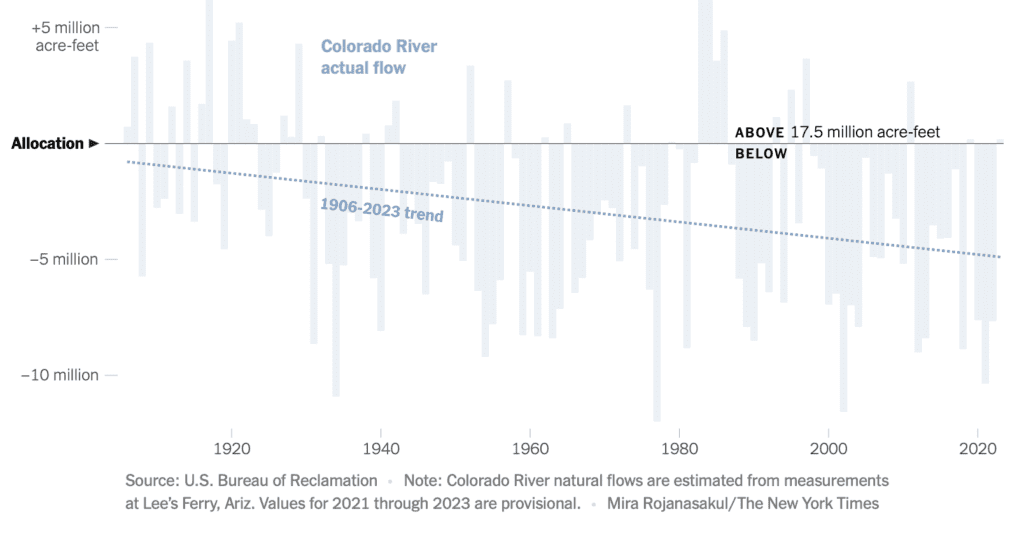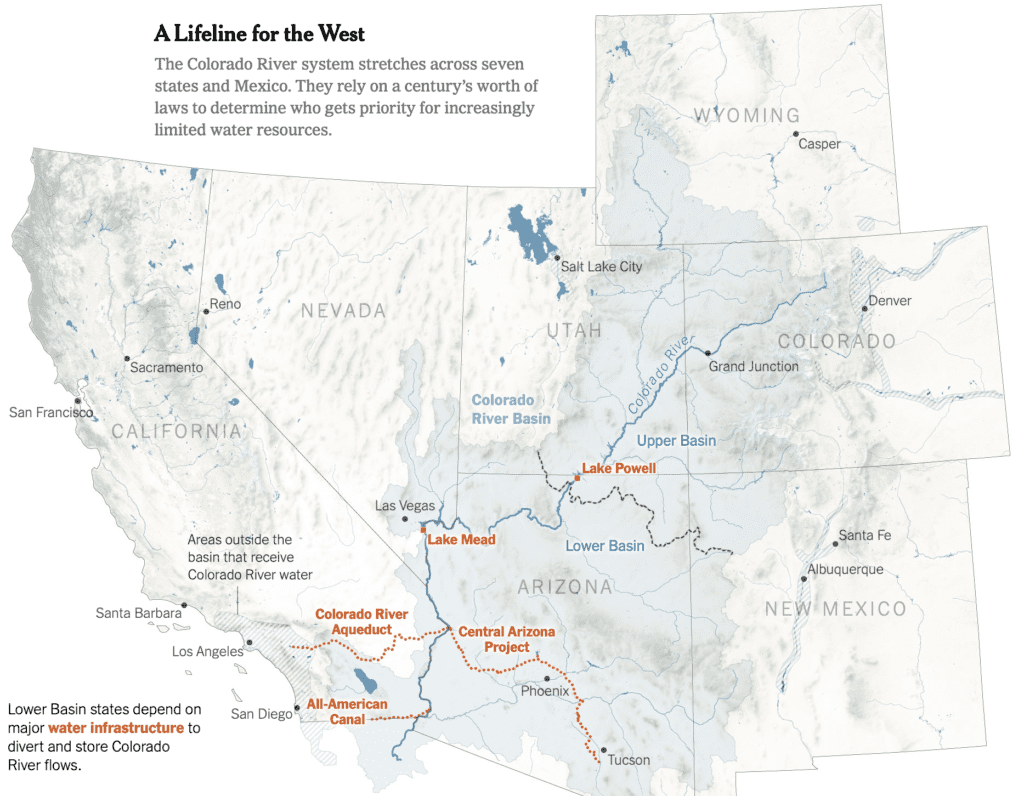Daniel Salzler No. 1238
EnviroInsight.org Six Items January 26, 2023
—————Feel Free To Pass This Along To Others——————
If your watershed is doing something you would like others to know about, or you know
of something others can benefit from, let me know and I will place it in this Information .
If you want to be removed from the distribution list, please let me know.
Please note that all meetings listed are open.
Enhance your viewing by downloading the pdf file to view photos, etc.
The attached is all about improving life in the watershed through knowledge.
If you want to be removed from the distribution list,
please let me know. Please note that all meetings listed are open.
Check our website at EnviroInsight.org
1. Colorado River States Are Racing to Agree on Cuts Before Inauguration Day
California, Arizona and others, fearing a political shake-up of negotiating teams after the November election, are aiming to wrap up work this year

The states that rely on the Colorado River, which is shrinking because of climate change and overuse, are rushing to agree on a long-term deal to share the dwindling resource by the end of the year. They worry that a change in administrations after the election could set back talks.
Negotiators are seeking an agreement that would prepare for extraordinary cuts in the amount of river water that can be tapped. The Colorado provides drinking water to 40 million people in seven states, 30 tribes and Mexico, as well as irrigation for some of America’s most productive farmland.
But the amount of water flowing in the Colorado has declined over time as rising temperatures reduce the snowpack that feeds the river.
“How do we live with the river that we have, not the river that we hope and dream for?” said Becky Mitchell, the lead negotiator for the state of Colorado.
The Colorado River’s Declining Flow
Water allocations are based on an assumed 17.5 million acre-feet of Colorado River flow, but the river’s actual flow has often been lower.

The rules that govern the distribution of Colorado River water expire at the end of 2026. Negotiators are trying to reach a deal quickly, in case the White House changes hands. It’s not the prospect of a Republican administration that is particularly concerning, negotiators said, but rather a change in personnel and the time required to build new relationships between state and federal officials.
“Whenever there’s an administration change, that significantly disrupts things,” said JB Hamby, chairman of the Colorado River Board of California and that state’s lead negotiator. “If we can get a draft ready and in place by the end of the year, that will ensure that we get the hard work done.”
The Colorado River hit a crisis a year and a half ago, when dangerously low water levels threatened the water supply for California, Arizona and Nevada, prompting the Biden administration to seek an agreement among states on deep cuts. That crisis receded after last year’s unusually wet winter, which temporarily reduced pressure on the river; in May, California, Arizona and Nevada agreed to more modest reductions than what the government had initially sought.
But those negotiations were a precursor to a much harder challenge. Whatever agreement replaces the current rules will require far deeper reductions than in than in the past.
“We all have to live within our means,” said Adel Hagekhalil, general manager of the Metropolitan Water District of Southern California, the largest wholesale drinking water supplier in the country, which gets half its water from the Colorado River. The challenge, he said, “is figuring out how we’re going to share.”

Those negotiations are taking place against the backdrop of scant snowfall so far this winter. On Tuesday, California reported that its snowpack was just one-quarter of the average level for this point in the season. Monitoring sites across the Colorado River basin report snow measurements that are less than half their usual levels.
That below-average snowfall “has reinforced that you can potentially have a bad year after a good year,” said Tom Buschatzke, director of Arizona’s Department of Water Resources and the state’s lead negotiator in the talks. “The dry conditions that are leading to a decline in the flow of the river are probably our long-term future.”
Time is short to reach an agreement. The federal agency in charge of the Colorado River, the Bureau of Reclamation, has asked states to propose an agreement by early March, so that the department can issue draft regulations by December — weeks before Inauguration Day.
Even if the Biden administration stays in office, finalizing the new rules before the current agreement expires at the end of 2026 will require moving quickly, according to Mr. Buschatzke.
That gives states just two months to decide a wide range of questions, including what level of water reductions they should plan for, based on how much the flow of the Colorado might shrink during the course of the deal.
Still, negotiators say they’re optimistic about reaching an agreement. Part of the reason is the significant federal spending on new infrastructure to use water more efficiently, which makes it easier to absorb cuts, according to Camille C. Touton, commissioner of the Bureau of Reclamation.
She pointed to investments like water recycling in the Gila River Indian Community, south of Phoenix, which returns water to the Colorado River system.
“Funding from the Biden administration allowed us not just to plan for rainy days,” Ms. Touton said in an interview. “This is our plan in case it didn’t rain.”
But even with those investments, states throughout the Southwest will need to absorb huge cuts in water use. Las Vegas, which depends on water from the Colorado River, recently outlawed lawns, which account for a significant portion of municipal water use. The city has also imposed a moratorium on evaporative cooling in new buildings, in favor of other types of air-conditioning that use less water.
John J. Entsminger, head of the Southern Nevada Water Authority and his state’s lead negotiator in the talks, said other cities and states in the basin would need to adopt similar degrees of change.
“It’s going to be difficult,” Mr. Entsminger said. “But it can be done.” Source: The New York Times
2. The EWG Dirty Dozen Foods For 2023. These foods contain high levels of pesticides on them, so wash/peel before consuming.
1. Strawberry
2. Spinach
3. Kale, Collards & Mustard Greens
4. Peaches
5. Pears
6.. Nectarines
7. Apples

8. Grapes
9. bell and Hot Pepppers
10. Cherries
11. Blueberries

12. Green Beans
The EWG suggests purchasing organically grown foods to avoid the pesticides. Source: The Environmental Working Group
3. Did You Know You Can Sigh Up For Tucsons Climate Action Newsletter? The City of Tucson provides monthly updates on the implementation of the Climate Action and Adaption Plan, known as Tucson Resilient Together. The monthly Climate Action Report provides an in-depth analysis of the efforts across Tucson to advance Mayor and Council’s goal of carbon neutrality by 2030 for City operations. This month, dive deeper into the FoodCycle at Home Program, a pilot project to divert food waste from landfills.
Climate Action Report signup
January 2024 Climate Action Report
4. ADEQ Requests Feedback On Five Year Rule Review. The Arizona Department of Environmental Quality invites interested community members, businesses, and government personnel to participate in a review of Arizona Administrative Code, Title 18. chapter 2 Air Pollution Control:
Appendices 1: Repealed, 2: Test Methods and Protocols, & 3: Logging

Please review the above guides and then participate in the SURVEY to participate before February 2, 2024. Copy and paste this link to your browser https://www.surveymonkey.com/r/5YRR-ch2-ap1-3_9
5. Learning Something New: Andragogy Part of speech: noun Pronounced as AN-drə-gah-jee
Origin: Greek, 1920s
1. The method and practice of teaching adult learners.
2. Adult education.
Examples of andragogy in a sentence
“I prefer andragogy; I work better with adults than with kids.”
“Since she was teaching adult learners this year, she had to quickly adapt to the techniques of andragogy.”
Source: Word Genius
6 Early Bird Registration Is Now Open For Water Resource Research Center”s (WRRC’s) 2024 Annual Conference.

Early registration for our two-day conference & reception is $160.
Standard registration, beginning February 13, increases to $175.
Discounted student registration is $60.
The WRRC Annual Conference will be held on March 12–13, 2024, at the University of Arizona Student Union Grand Ballroom, with livestreaming available. The program for this year’s theme, Implementing Water Solutions Through Partnerships, will showcase collaboration-based solutions across the state through speaker presentations and panels, while providing networking opportunities that include an evening reception and poster session. This year’s conference will bring new information to the table regarding solutions to Arizona’s water challenges, aiming to inspire new partnerships and collaborations.
Register at https://www.eventbrite.com/e/wrrc-2024-annual-conference-tickets-760050460387
Copyright: 2023 EnviroInsight.org
